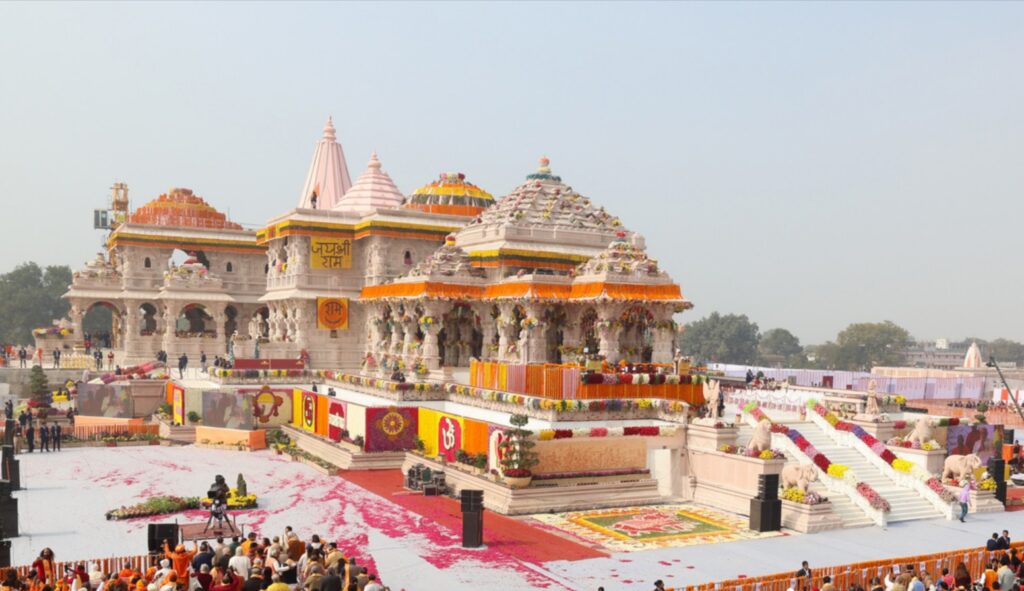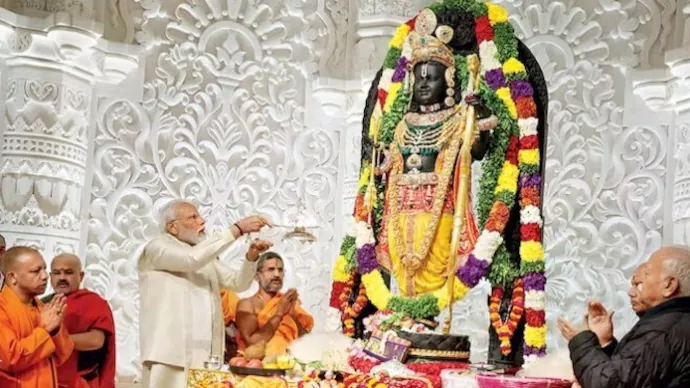
Ram Mandir, Ayodhya, a grand Hindu temple inaugurated on January 22, 2024, at a site in Ayodhya, Uttar Pradesh, India, believed to be the birthplace of the Hindu deity Ram.
The site at which the under-construction Ram Mandir stands has long been an area of conflict. The Hindu community considers it Ram Janmabhoomi, or Ram’s birthplace, while the Muslim community holds it sacred as the spot where the 16th-century Babri Masjid stood, and numerous lawsuits were filed by both communities for possession of the site.
Ram Mandir Inauguration
The temple’s consecration ceremony, or prana pratishtha (establishment of life force), held on January 22, 2024, was attended by about 7,000 guests, including Bollywood celebrities, prominent athletes, business personalities, and spiritual leaders, among others.
Indian Prime Minister Narendra Modi presided at the ceremony. With Bharatiya Janata Party (BJP) workers going door-to-door in Delhi to invite residents to the temple after the consecration ceremony, theaters such as PVR INOX hosting live streams for viewers, TV channels broadcasting the consecration ceremony live, and airlines offering special flights between Delhi and Ayodhya on the inauguration day, this was a widely publicized and intensively marketed event.
PM Modi during Pran Prathistha ceremony at the Ram Mandir in Ayodhya .

Temple structure
The Shri Ram Janmabhoomi Teerth Kshetra Trust, set up by the Government of India, is responsible for the construction and management of the temple. The main temple is built over 2.7 acres (1.1 hectares), and the temple complex is spread over an area of 70 acres (28 hectares).Work on the temple and the surrounding complex is being completed in phases. The construction of the temple’s ground floor, with the garbhagriha (“womb room”) for the deity, was completed in time for the consecration ceremony in 2024.
Devotee Stay
There are several hotels and dharamshalas near temple as per its popularity and the devotion of pilgrims for lord Ram.The temple has increased tourist visits to Ayodhya and thus booming the hospitality market.
Aarti
The Ram Temple in Ayodhya, Uttar Pradesh, has become a major pilgrimage site, attracting a massive crowd of around 1 to 1.5 lakh devotees daily. The Shri Ram Janmbhoomi Teerth Kshetra, the trust responsible for the temple’s construction and management, has implemented new guidelines to manage the influx of pilgrims effectively.
Entry Timings
Devotees can enter the Shri Ram Janmabhoomi Mandir for Darshan between 6:30 AM to 9:30 PM daily. The entire process, from entry to exit after Darshan, has been designed to be extremely straightforward and convenient, typically taking about 60 to 75 minutes.
- Devotees are advised to leave their mobile phones, footwear, purses, etc., outside the Mandir premises for their convenience and to save time.
- Devotees are requested not to bring flowers, garlands, prasad, etc., to the Shri Ram Janmabhoomi Mandir.
Special Aarti Timings and Special passes
Entry passes are required for special Aartis, including the Mangala Aarti at 4 AM, Shringar Aarti at 6:15 AM, and Shayan Aarti at 10 PM. These passes can be obtained free of charge from the Shri Ram Janmabhoomi Teerth Kshetra Trust website. Ensure to provide necessary information such as name, age, Aadhar card details, mobile number, and city for the entry pass.
How to reach
By Road
Services of Uttar Pradesh Transport Corporation buses are available 24 hrs a day, making it an easy journey. Ayodhya is about 130km from Lucknow,200km from Varanasi, 160km from Prayagraj, 140km from Gorakhpur, 636km from capital of the country Delhi.
By Train
There are two main and nearby railway stations to this city Ayodhya junction and Faizabad junction.
By Air
Nearest airports are:
- Gorakhpur airport which is 118km from Ayodhya.
- Amausi airport,Lucknow which is 125km from Ayodhya.
